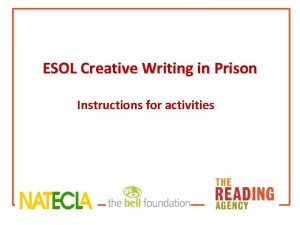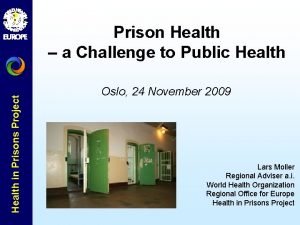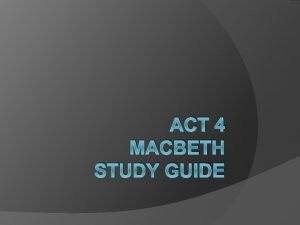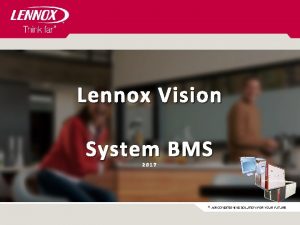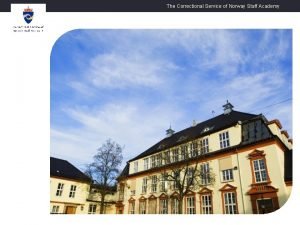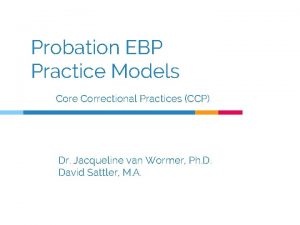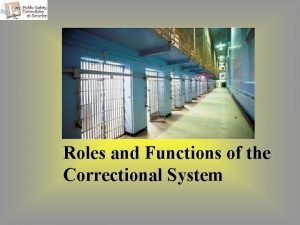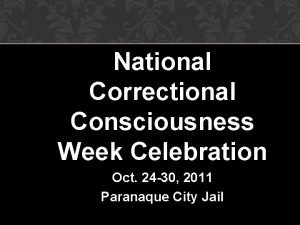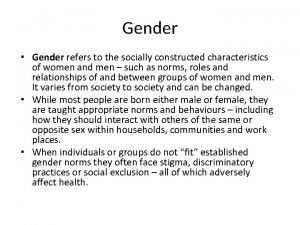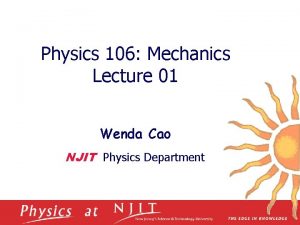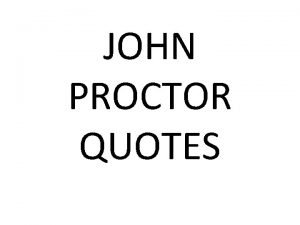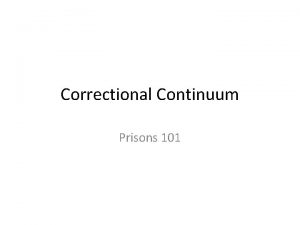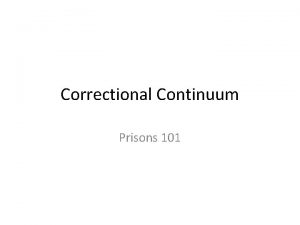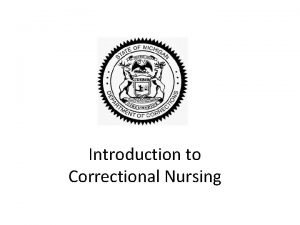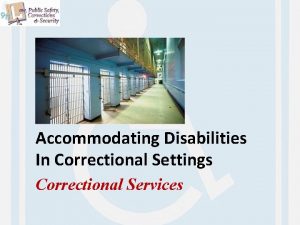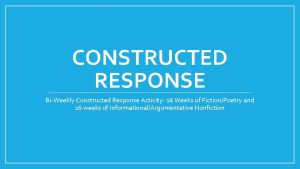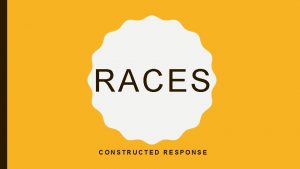CORRECTIONAL INSTITUTIONS Lennox 1990 quotes Prisons are constructed





























- Slides: 29

CORRECTIONAL INSTITUTIONS Lennox (1990) quotes: ”Prisons are constructed in the interests of those who do not use them, thus there is no understanding of what makes them ’work’”. Each generation discovers anew the scandals of incarnation, each sets out to correct them, each passes on a legacy of failure – we inherit in essence a two hundred year history of reform without change” Summary: - The prevalence of ill health is inevitably linked with imprisonement. - The incidence of problems is linked with the type of housing. - Prison crowding is more significant than social crowding. - The variable effects on inmates are related to personal characteristics and backgrounds - The reactions of inmates are related to their personal characteristics. Janssens, J. & Laike, T. (2006) Rum för återanpassning. (Statens institutionsstyrelse Si. S 2/06)

Literature search: - Psyc. Info - Psyc. Articles - Dissertation Abstracts Key words: or institution or detention or correction or confinement or prison or jail or penitentiary or juvenile and environment or design or architectur* or surrounding or physic* (human population) about 5 000 hits of which about 100 relevant articles of which about 30 about ”crowding” Janssens, J. & Laike, T. (2006) Rum för återanpassning. (Statens institutionsstyrelse Si. S 2/06)

Crowding correlated with - illness - physical symptoms - high blood pressure - negative housing evaluations - high stress - negative effects in juvenile institutions - women more sensitive Other psychological factors - consistency and gentleness in therapeutic environment - psychosocial aspects in Prison Preference Inventory - poor mental health with little mental stimulation - arguments for more humane prison environments - changes in brain activity and solitary confinement - child development and environmental orientation - relation between arousal, affect and cognition - prisoners attitudes towards their environments’ attractiveness - cognitive impairment in impoverished environments Janssens, J. & Laike, T. (2006) Rum för återanpassning. (Statens institutionsstyrelse Si. S 2/06)

Prison building estate/architecture/characteristics and - crime prevention - historical development and implications - jail design supporting direct supervision is successful - inmate violence - psychological effects - isolation promotion Physical environmental factors and - criminal activity - private and public juvenile correctional facilities - effects on behavior in youth offenders - prison officers’ stress - rehabilitation intervention - description of characteristics - problem generation - needs of juvenile group homes - prison life amelioration Janssens, J. & Laike, T. (2006) Rum för återanpassning. (Statens institutionsstyrelse Si. S 2/06)

Correctional/therapeutic/educational/school environments - alternative school settings for safety - appropriate gaming environments in training programs - misfits of therapeutic environments in prisons - demand for trustworthy and warm educational environments Comparisons - open vs. closed units prison-based and normal wing environments pre- and post-conversion evaluations comparing jail types and assessing instruments New Generation and Traditional Linear jail comparison relocation and health effects single rooms and squads and stress levels privacy and control before and after moving to new facility comparing circular pavilions with ordinary therapeutic environments - user assessments of two specially designed detention centers Janssens, J. & Laike, T. (2006) Rum för återanpassning. (Statens institutionsstyrelse Si. S 2/06)




Design and features - furniture rearrangement and climate - classroom seating and juvenile delinquency - effects of signs on perceived crowding and behavior - effects of windows on health and wellbeing - effects of illumination levels - the Baker-Miller pink effect - no effects of rainfall, temperature, seasons or moonphase - music exposure and behavior - pets/animals in correctional institutions Work environment/involvement - staff perceptions and evaluations of their work/environment - recipient involvement in environmental change project - prison simulation and interpersonal dynamics Outdoor therapy/bootcamps - bootcamps vs traditional institution environment - benefits of outdoor challenges - psychopedagogical aspects of soccer Janssens, J. & Laike, T. (2006) Rum för återanpassning. (Statens institutionsstyrelse Si. S 2/06)

Environmental psychology research: “too little experimentation on institutional design” Why? - Architecture lacks a tradition of research - General overlooking of the role of the physical environment in institutional care - Difficulties for good research because of problems with experimental control - Practitioners have difficulties in understanding and demanding research Correctional institutions: involuntary environments: - Hospitals, health care centers - Schools, educational facilities - Work places Janssens, J. & Laike, T. (2006) Rum för återanpassning. (Statens institutionsstyrelse Si. S 2/06)

From: Küller, R. (1991) Environmental assessment from a neuropsychological perspective (In T. Gärling & G. W. Evans (Eds. ) Environment, Cognition and Action: An Integrated Approach, pp. 111 -147. Oxford University Press, New York)

Environmental psychology research on work places (Sundstrom, 1987) Janssens, J. & Laike, T. (2006) Rum för återanpassning. (Statens institutionsstyrelse Si. S 2/06)

Work place physical attributes and organization Dimensions of Organizational Structure Properties of the Physical Environment - Size - Technology - Configuration - Interdependence - Specialization - Centralization - Formalization of roles - Standardization - Space - Automation - Delineation and differentiation - Proximity - Differentiation by job or task/Enclosure - Uniformity of work spaces/Visual accessibility - Differentiation by rank - Rigidity of layout Janssens, J. & Laike, T. (2006) Rum för återanpassning. (Statens institutionsstyrelse Si. S 2/06)

Work place physical attributes and interpersonal relationships Symbolic Work Spaces (e. g. expressions of Self-Identity) - Personalization (recognition) - Territoriality (regulate social interaction, trait? ) - Participative design - Status Markers (greater floor space, greater physical enclosure) Communication - Physical Accessibility: no conclusive effects of proximity - Ambient Conditions: - Seating Arrangements and Psychological Distance Privacy - Enclosure Small Groups - Development of small, informal groups - Enclosure and cohesion - Patterns of interaction Janssens, J. & Laike, T. (2006) Rum för återanpassning. (Statens institutionsstyrelse Si. S 2/06)

Work place physical attributes and the individual - Temperature (dependent on relative humidity, speed of air movement, presence of radiant sources of heat or cold, level of activity, clothing, a. s. o. ): Laboratory research with mental, motor, vigilance and dual tasks: - for satisfaction: 22°C (20 -24°C), 10% too cold, 10% too warm - for performance: arousal and distraction (at least initially) - Air Quality (dependent on unwanted constituents such as gas, dust, mist, vapor, fiber, smoke, ventilation, a. s. o. ) Air pollution and smell: significantly associated with dissatisfaction with the physical environment - main problem: cigarette smoke Janssens, J. & Laike, T. (2006) Rum för återanpassning. (Statens institutionsstyrelse Si. S 2/06)

Work place physical attributes and the individual - Lighting (intensity and quality, dependent on glare, uniformity, age) with - daylight (windows more satisfying) and artificial light - for satisfaction: 40 -80 footcandles (500 -900 lux) - for performance: dependent on task, glare is distracting and disturbing - Color (hue, blackness, chromaticness, amount, size, diversity) - for satisfaction: blue, red, a. s. o. , light, pure, saturated - for performance: warm colors lead to increased arousal - affect perception of room size and object size and weight (stronger colors appear closer and heavier) Den fysiska miljöns betydelse inom tvångsvården: miljöpsykologiska aspekter (051201)

Work place physical attributes and the individual - Noise (unwanted sounds, conversations by co-workers and ringing of telephones): predictable or unpredictable - for satisfaction: “quiet”, low “peak level” of sounds audible above background sounds - for performance: dependent on arousal, distraction, overload, meaning, aftereffects, control a. s. o. < 100 d. B - Music (dependent on type and level): - for satisfaction: positive as background when workers capacities are not absorbed by their work (probably only routine work) - for performance: enhance vigilance when synchronized with task Janssens, J. & Laike, T. (2006) Rum för återanpassning. (Statens institutionsstyrelse Si. S 2/06)

Environmental psychology research on work places (Sundstrom, 1987) Janssens, J. & Laike, T. (2006) Rum för återanpassning. (Statens institutionsstyrelse Si. S 2/06)

Evolutionary studies (explorative studies): - Institution design historically, directed by technical, moral, political developments - Concepts: (a) bigness vs. smallness, (b) compactness vs. linearity; (c) low-rise vs. mid- or high-rise; (d) centralized vs. decentralized - Architectural styles: e. g. functional deconstruction (less forbidding) - Trends today: - Values: systems and facilities which most effectively deliver actual and perceived quality care - Facility as tool and healer (psychophysiological effects) - Prospects: ambulatory care facilities, outcustom care facilities Evaluation studies (field studies): - What do customers want (market research) - Comparisons of alternatives - Participatory planning, Post Occupancy Evaluations (POE) - Work environment assessments Experimental studies (laboratory studies): - Mostly on ambient environmental factors Janssens, J. & Laike, T. (2006) Rum för återanpassning. (Statens institutionsstyrelse Si. S 2/06)

Environmental Psychology Handbook Index Subjects -Acoustic environment, : noise, music -Aesthetics -Air pollution, quality -Animals -Apartments -Arousal -Building materials: physiological responses, toxic effects -Children and institutional environments, 298 -303 -Color -Comfort -Communication -Complexity -Constraints -Control -Coping -Crime -Crowding -Daylight -Defensible space -Density -Dormitories -Environmental design -Environmental stimulation -Environmernt and behavior -Fear -Group spaces -Heat -Helping behavior -Helplessness -High schools -Hospitals, visitors, 941 -Humidity -Infrasound -Intrusion -Isolation -Job performance, satisfaction -Learning environments -Light, lighting -Monotony -Music -Mystery -Natural environment, nature -Noise -Novelty -Odors -Office -Outdoor environments -Overload -Participative design -Personality Janssens, J. & Laike, T. (2006) Rum för återanpassning. (Statens institutionsstyrelse Si. S 2/06) -Personalization -Personal space -Physical environment -Place -Post Occupancy Evaluations -Preference -Prisons -Privacy -Rooms -Satisfaction -Scale -Schools -Seating -Settings -Space -Spatial behavior -Stress, stressors -Temperature -Territoriality -Therapeutic environments -Thermal comfort -Ventilation -Violence -Vulnerability -Wayfinding -Well-being -Windows -Work environments


Architecture and Stress (Evans, 1998) - Stimulation: intensity, complexity, mystery, novelty - Coherence: legibility, organization, structure, landmark - Affordances (action possibilities): ambiguity, sudden change, conflict, feedback - Control: boundaries, hierarchy, territoriality, symbolism, privacy - Restorative: minimal distraction, stimulus shelter, fascination Janssens, J. & Laike, T. (2006) Rum för återanpassning. (Statens institutionsstyrelse Si. S 2/06)

Stimulation: intensity, complexity, mystery, novelty - vertical fragmentation - staircases - complicated floor plans - no focal points - different shapes and forms - different materials and colors - close interpersonal distances - Optimate with moderate levels of stimulation - Lack of stimulation: boredom, sensory deprivation: bad accomodation to environmental challenges - Too much stimulation: distraction, overload, interferes with demanding cognitive processes Janssens, J. & Laike, T. (2006) Rum för återanpassning. (Statens institutionsstyrelse Si. S 2/06)

Stimulation: intensity, complexity, mystery, novelty - partial vistas - spaces not fully comprehensible without exploration - building layouts portending but not restricting happenings - Familiarity and routine will influence reactions to stimulation - Lack of mystery: trivial prediction - Too much mystery: confusion and unanalyzable - Promotes meaningful problem solving Janssens, J. & Laike, T. (2006) Rum för återanpassning. (Statens institutionsstyrelse Si. S 2/06)

Coherence: legibility, organization, structure, landmark - clarity of underlying or thematic patterns of stimulation - multiple repetitive features - underlying expression of rules - thematic continuity - unambiguaous information - regular geometric shapes - distinctive interior markings - views of the external environment - Decreases the potential for misbehavior - Facilitates orientation and wayfinding Janssens, J. & Laike, T. (2006) Rum för återanpassning. (Statens institutionsstyrelse Si. S 2/06)

Affordances: ambiguity, sudden change, conflict, feedback - good design - clear cues - no competing cues - Decreases frustration and annoyance - Diminishes hostility and helplessness Janssens, J. & Laike, T. (2006) Rum för återanpassning. (Statens institutionsstyrelse Si. S 2/06)

Control: boundaries, hierarchy, territoriality, symbolism, privacy - physical constraints - flexibility - openness, moveable partitions - visual or acoustic permeability - responsiveness to feedback - spatial syntax, depth, focal points - defensible space - symbolic elements, power - furniture arrangements - Decreases stress - Hinders learned helplessness - Regulates use and occupancy of space - Promotes effective interaction with physical and social environment - Enhances feelings of empowerment - Promotes feelings of personal or group identity Janssens, J. & Laike, T. (2006) Rum för återanpassning. (Statens institutionsstyrelse Si. S 2/06)

Restorative: minimal distraction, stimulus shelter, fascination - retreat - exposure to nature - window views - burning fireplaces - animals, aquariums, moving water - Functions therapeutically - Reduces mental fatigue and other stress - Buffers negative effects of residential crowding and noise Janssens, J. & Laike, T. (2006) Rum för återanpassning. (Statens institutionsstyrelse Si. S 2/06)

Where is the visitors’ entrance? Which elevator push-button goes where? Which corridor is the most narrow?
 Insidan region jh
Insidan region jh Esol prisons
Esol prisons Hobbs and holt token economy
Hobbs and holt token economy Famous san quentin prisoners
Famous san quentin prisoners Health in prisons project
Health in prisons project Internal forms of social control criminology
Internal forms of social control criminology Whos ghost does macbeth see
Whos ghost does macbeth see Who are the thanes in macbeth
Who are the thanes in macbeth What does macduff vow
What does macduff vow Eduqas english language past papers 2017
Eduqas english language past papers 2017 What news does lennox give to macbeth
What news does lennox give to macbeth Serwis rooftop lennox
Serwis rooftop lennox Correctional nursing
Correctional nursing Office of correctional education
Office of correctional education University college of norwegian correctional service
University college of norwegian correctional service Georgia correctional healthcare
Georgia correctional healthcare Core correctional practices examples
Core correctional practices examples Correctional funnel
Correctional funnel 3rd degree felony
3rd degree felony Correctional officer rank structure
Correctional officer rank structure Collins correctional facility
Collins correctional facility What is corrections in criminal justice
What is corrections in criminal justice Office of the correctional investigator
Office of the correctional investigator Department of correctional services strategic plan
Department of correctional services strategic plan Sexual harassment cases in correctional centres
Sexual harassment cases in correctional centres Compulsory drug treatment correctional centre
Compulsory drug treatment correctional centre Leadership styles in correctional facilities
Leadership styles in correctional facilities National correctional consciousness week
National correctional consciousness week Gender refers to
Gender refers to A race track is constructed such that two arcs of radius 80
A race track is constructed such that two arcs of radius 80

